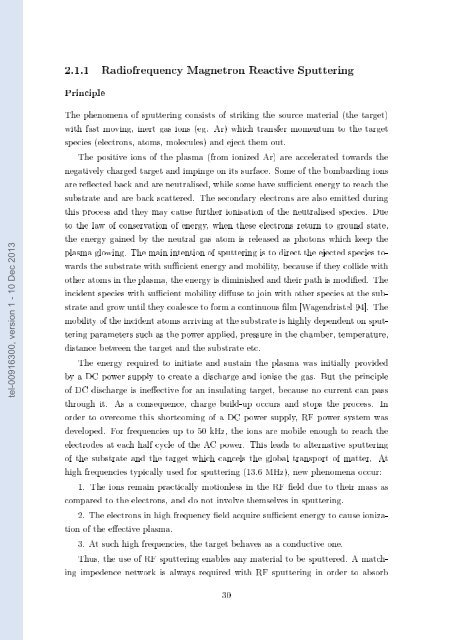Films minces à base de Si nanostructuré pour des cellules ...
Films minces à base de Si nanostructuré pour des cellules ...
Films minces à base de Si nanostructuré pour des cellules ...
Create successful ePaper yourself
Turn your PDF publications into a flip-book with our unique Google optimized e-Paper software.
2.1.1 Radiofrequency Magnetron Reactive Sputtering<br />
Principle<br />
tel-00916300, version 1 - 10 Dec 2013<br />
The phenomena of sputtering consists of striking the source material (the target)<br />
with fast moving, inert gas ions (eg. Ar) which transfer momentum to the target<br />
species (electrons, atoms, molecules) and eject them out.<br />
The positive ions of the plasma (from ionized Ar) are accelerated towards the<br />
negatively charged target and impinge on its surface. Some of the bombarding ions<br />
are reected back and are neutralised, while some have sucient energy to reach the<br />
substrate and are back scattered. The secondary electrons are also emitted during<br />
this process and they may cause further ionisation of the neutralised species. Due<br />
to the law of conservation of energy, when these electrons return to ground state,<br />
the energy gained by the neutral gas atom is released as photons which keep the<br />
plasma glowing. The main intention of sputtering is to direct the ejected species towards<br />
the substrate with sucient energy and mobility, because if they colli<strong>de</strong> with<br />
other atoms in the plasma, the energy is diminished and their path is modied. The<br />
inci<strong>de</strong>nt species with sucient mobility diuse to join with other species at the substrate<br />
and grow until they coalesce to form a continuous lm [Wagendristel 94]. The<br />
mobility of the inci<strong>de</strong>nt atoms arriving at the substrate is highly <strong>de</strong>pen<strong>de</strong>nt on sputtering<br />
parameters such as the power applied, pressure in the chamber, temperature,<br />
distance between the target and the substrate etc.<br />
The energy required to initiate and sustain the plasma was initially provi<strong>de</strong>d<br />
by a DC power supply to create a discharge and ionise the gas. But the principle<br />
of DC discharge is ineective for an insulating target, because no current can pass<br />
through it. As a consequence, charge build-up occurs and stops the process. In<br />
or<strong>de</strong>r to overcome this shortcoming of a DC power supply, RF power system was<br />
<strong>de</strong>veloped. For frequencies up to 50 kHz, the ions are mobile enough to reach the<br />
electro<strong>de</strong>s at each half cycle of the AC power. This leads to alternative sputtering<br />
of the substrate and the target which cancels the global transport of matter. At<br />
high frequencies typically used for sputtering (13.6 MHz), new phenomena occur:<br />
1. The ions remain practically motionless in the RF eld due to their mass as<br />
compared to the electrons, and do not involve themselves in sputtering.<br />
2. The electrons in high frequency eld acquire sucient energy to cause ionization<br />
of the eective plasma.<br />
3. At such high frequencies, the target behaves as a conductive one.<br />
Thus, the use of RF sputtering enables any material to be sputtered. A matching<br />
impe<strong>de</strong>nce network is always required with RF sputtering in or<strong>de</strong>r to absorb<br />
30
















